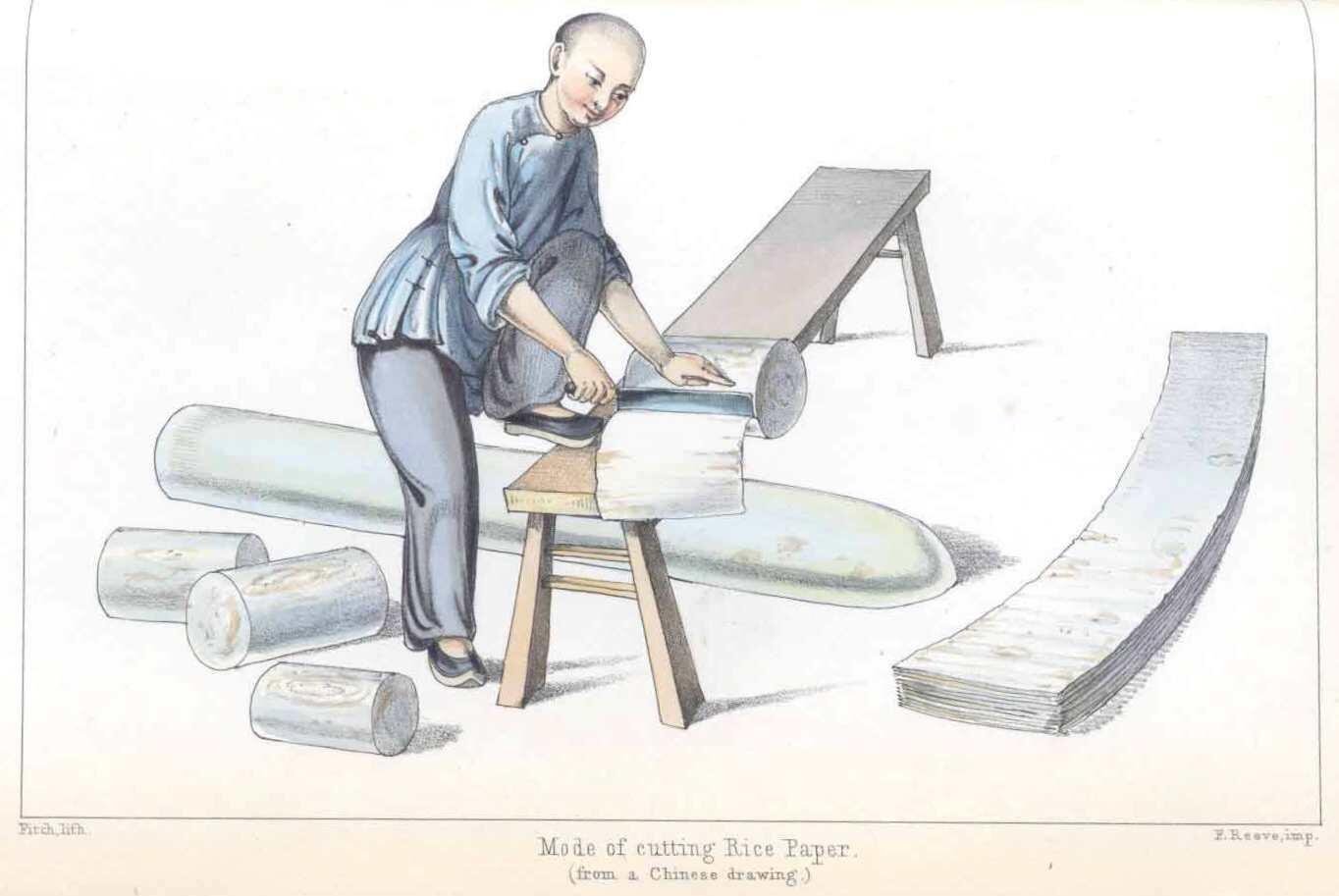Harvesting
Harvesting to Produce Pith Paper
The harvesting of Tetrapanax papyriferum to make paper from its pith is a varied process. The plant can be harvested at any season, usually at 2 to 3 years old when the main stems are 5 to 6 feet. Extraneous leaves and twigs are removed and the stems are soaked in water to loosen the pith. These stems are then cut into 12"-18" pieces and the pith itself is forced out. The pith is a brilliant white, but must be dried immediately or it will yellow and stain; this is attained by exposing the pith to the sun for several days.
In cutting the pith to make the paper, the longer, dry lengths are cut into shorter pieces that are then "peeled" away using a short-handled, razor-sharp knife with a 12" blade, 3" wide and 1/2" thick. This produces a scroll-like sheet about 4 to 6 feet long. The first 10 to 20 inches are grooved and irregular in cut, with jagged, course brown areas, which are then cut away. It takes a very skilled worker to produce the pristinely smooth, white paper that is uniformly thick; training to cut smaller strips takes a minimum of 1 year, while to produce wider strips, the training is more extensive.
Pith paper is characterized by its great strength; when it is damp, it may be stretched and folded freely and when it is moistened it can be formed into almost any shape. This makes it ideal for water-based paintings that create a raised, relief pattern almost immediately upon application of medium. Unfortunately, it is very brittle when dry, grows more fragile with age, and is prone to discoloration.
Below is an excerpt from Chinese "Rice-Paper" or "Bok-Shung" in Hooker's Journal of Botany and Kew Garden Miscellany Volume II, 1850, detailing the first samples of pith and sample tools received by Hooker:

"Thanks to our most obliging friend, Capt. Wm. Loring, R.N., who has put us in communication with several intelligent gentlemen now resident in China, we are in a fair way of obtaining correct intelligence relative to many interesting scientific objects, and of having our doubts solved on some important botanical matters. J. H. Layton, Esq., H.B. Majesty's Consul at Amoy, China, has most kindly sent us not only excellent specimens of the pith from which the so-called Rice paper is formed, but a model of the knife used in cutting it, and, what is even of more value, the following information.
"The substance, commonly called Rice-paper by the Chinese, is made from the pith of a plant or tree, which grows principally in the swampy grounds in the province of Sam-swi, in the northern part of the island of Formosa, where it is said to form large forests. The bark and rind are, previous to exportation, stripped from the pith, which is then called Bok-shung."The iron knife commonly used for cutting this pith weighs about 2 1/2 lbs., and is of the roughest and coarsest workmanship, and perhaps not one blade in twenty is sufficiently well tempered to be advantageously used. In cutting, the knife is kept quite steady, the cylindrical pith being moved round and round against the edge of the knife which is just inserted into the substance, and thus a leaf or sheet is formed resembling the most delicate paper, but rather thick in substance. When brought quickly from the workman's hands the paper is in a damp state. It may have been rendered so, in order to facilitate the smoothing and pressing.
"At Chang-chew, the large city of which Amoy is the sea-port, there is only one man who can cut this paper. This person ran away from his master in Formosa, and refuses to teach his trade except for a premium of 60 dollars....
"We have the gratification of knowing that our Consul at Amoy will use his best endeavors to procure flowering specimens of the plant itself."